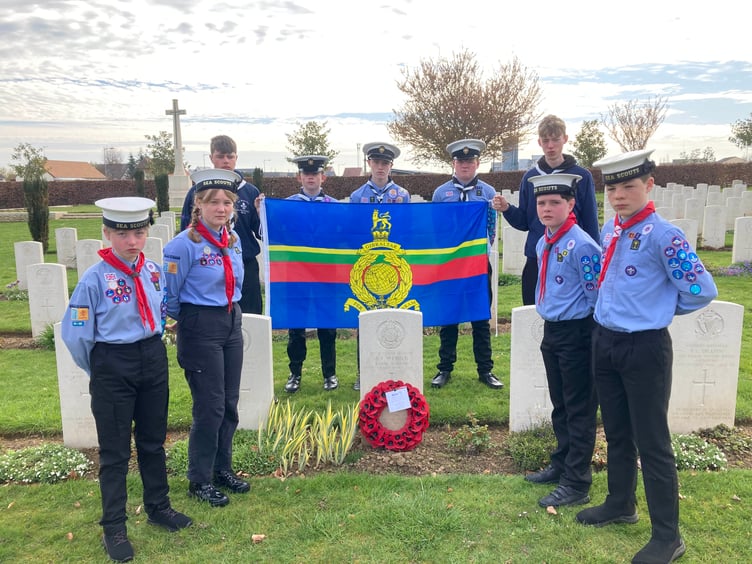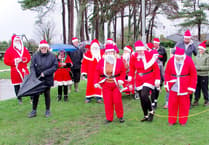THIRTY-four sea scouts, explorer scouts, and leaders from 1st Watchet Sea Scout Group have completed a five-day Easter cycling expedition along the D Day beaches in Normandy France, from the Cherbourg peninsula along the coast to Ouistreham, and inland toward Caen.
They left by ferry from Poole, in Dorset, and arrived in Cherbourg to make their way to Utah beach, part of the American sector during D Day, where they pitched their tents and camped the first night.
The second day saw the group start with a tour of the landings museum on the beach, learning about the assault by the Americans and how the German army had prepared its defences.
Following this visit, the group cycled inland to Sainte Mere Eglise, where on June 6, 1944, American paratroopers were tasked to capture the strategic road and crossroads.
Here, they visited the memorial museum commemorating the event and work of the American paratroopers from the 82nd and 101st airborne division.
The second night was spent back at Utah beach.
Day three saw the scouts drop their tents and proceed along the maritime cycle way, along the estuary leading toward the town of Carantan.
As experienced by the Americans in 1944, the only way to cross the estuary to link to the next set of beaches at Omaha was to cross the river inland at Carantan on one of the only bridges over the river and canal.
Having negotiated the marshland cycle paths, the scouts passed Carantan and headed to the coastal village of Grand Camp Maisey and the site of a lesser-known battle of the D Day campaign at the Maisey battery, a large gun battery which shelled Utah and Omaha beaches for days until it was neutralised by the American forces.
The much more familiar location of Pointe Du Hoc, where American Rangers stormed the cliffs was nearby, but, as known from the story of the invasion, the guns had not been installed and the battery was in fact operating at Grand Camp Maisey.
The scouts were able to spend several hours exploring this recently uncovered battery, before making their way to their next camp site at la Cambe, close to the German cemetery.
The scouts were able to learn about the German losses during the Second World War and about who were the soldiers fighting against the Allied troops.
Day four saw the scouts pack their tents again and move again along the coast toward Omaha beach, where so many American soldiers were killed as they battled to exit it on D Day.
Visiting the beach and nearby memorials and defences still in place, the scouts cycled inland to the American Cemetery at Colleville Sur Mer, the largest cemetery in Normandy with more than 9,000 graves.
Following this sombre experience, the group continued with their cycle along the coast toward Arromanche, the beginning of the British sector of Gold beach, stopping at the German battery at Les Chaos at Longues Sur Mer, which comprised large ex-ship guns and which was still virtually intact, having been captured by the Devonshire Regiment several days after the main invasion had taken place.
Stopping in Arromanche for a late afternoon ice cream, the scouts continued with their cycle on to the village of Asnelles, on Gold beachb where they again pitched their tents.
Day five was a rest day from cycling and the scouts had a small lie in, before making their way inland by minibus to the Commonwealth War Graves at Douvres La Delivrande, where they paid their respects to a Watchet man who died during the Normandy invasion.
Royal Marine Arthur Thomas Webber, from Wouldham Road, Watchet, died in action on August 17, 1944, two months after D-Day.
He was a gunner with the Marines on board Landing Craft Flak no 1, which was modified and fitted with anti-aircraft (flak) guns and machine-guns and used in defence of the landing troops.
On D Day, LCF1 was assigned to the landing of the Canadian divisions at Juno beach, at Courseulles Sur Mer.
Having completed this task, it spent the next two months patrolling the eastern flank of the landings at Ouistreham.
Together with other anti-aircraft and surface ships, LCF1 lined up each night off of Sword beach, stretching for six miles into the channel, to form what became known as ‘The Trout Line’.
The aim of this line of ships and landing craft was to defend the supply ships and beaches from night attacks by German torpedo boats and ‘human torpedos’ based at Le Havre, as well as air attacks from the German Airforce.
On August 17 at 05.30 hours, an attack began. LCF1 was at anchor when at 06.30 hours she was hit by a torpedo and blew up. All 70 members of the Royal Navy crew and Royal Marine gunners were killed.
Arthur Thomas Webber was laid to rest at the British War Cemetery at Douvres.
Also buried in the same cemetery were members of the Somerset Light Infantry, as well as other regiments with Westcountry connections.
A poppy wreath was laid by the troop at the headstone of Marine Webber’s grave on behalf of the Watchet Branch of the Royal British Legion and a short memorial service was held.
The scouts then walked around the cemetery and placed Remembrance crosses at the graves of some of the Somerset Light Infantry, Royal Navy, and Royal Marines who were laid to rest alongside Marine Webber.
On their way back to their camp site, the scouts visited the new British Normandy Memorial overlooking Gold and Juno beaches, where again a wreath was left at the base of the column with Marine Webber’s name engraved in his memory.
The afternoon was spent in the landing museum at Arromanche, where the scouts learned about the British sector of D Day and the Mulberry harbours which were constructed and towed to Arromanche to create a port for unloading supplies and reinforcements for the invasion.
A visit to the clifftop 360 degree cinema was also undertaken, watching a special film dedicated to the Normandy invasion.
During their visit to Arromanche, explorer sea scout Lewis Mossman was invested into scouting, next to a Sherman tank overlooking the mulberry harbour.
Day six saw the scouts back on their cycles, for the final leg of their expedition, cycling Juno and Sword beaches to the ferry terminal at Ouistreham, and then along the Caen Canal to the famous Pegasus bridge.
At the museum dedicated to the British Airborne division the scouts learned about the events in the early hours of June 6, when just after midnight the British secured the bridge and liberated the first part of France from the German occupiers.
The scouts learned about the gliders which brought the airborne division to land so close to the bridge and visited the actual sites at which the gliders landed.
Following the museum and original bridge tour, the scouts cycled inland to the village of Ranville and the Commonwealth War Graves, where many of the airborne troops and Royal Marines who landed nearby were laid to rest.
They again held a short service of remembrance before laying a memorial wreath on behalf of the Watchet Royal British Legion.
The scouts then cycled back to Ouistreham, where they had their evening meal and loaded their cycles onto a trailer before joining an overnight ferry to Portsmouth.
On arrival in Portsmouth, the scouts were welcomed on board HMS Excellent, at Whale Island, where they were provided with a full English breakfast by the Royal Navy before starting their return journey to Watchet.
Anybody who wants to know more about the expedition or about the 1st Watchet Sea Scout Group should email [email protected].





Comments
This article has no comments yet. Be the first to leave a comment.